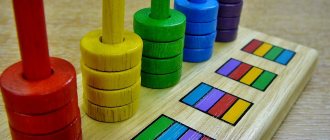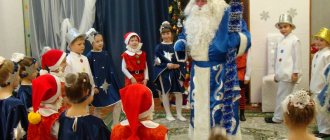The essence of play activities in kindergarten
Play in a preschool educational institution (DOU) is a form of social life of a child that promotes his physical, mental and intellectual growth, as well as cultivating strong-willed, moral qualities and creative abilities.
Through play, children learn to be creative
Goals
Based on the definition of play activity, it is possible to compile a list of target guidelines that determine its significance in kindergarten.
Educational
This group includes:
- organization of cognitive activity (as follows from practice, children quickly learn new knowledge in a playful way);
- broadening one's horizons (new types of activities or other forms of already familiar games reveal some unknown phenomena and facts for children, for example, by conducting a research game on growing a flower in a preparatory group, the children get acquainted with the concept of “cutting”, understand such a phenomenon as “anabiosis” etc.);
- the formation of skills and abilities (for example, during games on a walk, children learn by helping the janitor to remove snow from the paths, while the game task consists not only of the quality of cleaning, but also of speed, which fosters a sense of healthy competition).
Developmental
In this case, the mission of the game is to develop:
- attention (in order to be an equal participant in the game, the child needs not only to carry out his actions, but also to monitor what the other participants are doing);
- memory (the game requires memorizing not only the content of the game action, but also the rules, as well as a list of necessary attributes, variant conditions, etc.);
- speech (active interaction with each other replenishes the active and passive vocabulary of children);
- thinking (game activity includes all thinking processes through the need to compare, contrast, analyze);
- fantasies (children have the opportunity to try on different social roles - mother, teacher, doctor, etc., which is also important for determining their range of interests);
- feelings of responsibility for one’s physical condition;
Games help children understand the culture of a healthy lifestyle
- motivation of educational activities (children perceive didactic material not as a set of dry facts, but as an important component of fun).
Educational
Part of the triad of the target component of education in the game is implemented by education:
- independence (in the process of play activity, children 6–7 years old not only perform play actions themselves, but also come up with rules, for example, for role-playing fun);
- self-regulation (children learn not to give up what they start, to finish things, and not to give in to momentary feelings);
- sociability (interaction in most games involves communication with each other and with adults);
- feelings of cooperation;
- moral and aesthetic positions.
Tasks
In the context of achieving the set goals, by organizing and conducting games, the teacher solves the following tasks:
- teaches children a heuristic approach to acquiring knowledge (for example, in a didactic game of putting together puzzles with images of exotic birds, the teacher invites the children to find images of these birds in the reference book in order to get an idea of their appearance);
- develops the imagination of children, offering not a ready-made set of rules, for example, for an outdoor game, but only a basis so that children can figure out the plot of the fun themselves;
- improves coordination and fine motor skills (even in the preparatory group, games with mosaics are in great demand; to make it more difficult, you can lay out your own scenes with chips instead of ready-made pictures);
- fosters patience and a tolerant attitude towards comrades.
In the process of playing in small groups, children learn to be patient with their friends.
Diagnostics of gaming activity
Educational activities in kindergarten are carefully analyzed. Moreover, the analysis of the components of the educational process is carried out by the teacher himself, methodologists and colleagues. Self-analysis is necessary to identify and correct shortcomings in the organization and conduct of games, and third-party commentary is needed to draw up an overall assessment of the teacher’s competence in organizing the educational process. If we talk about a general assessment of the play activity of children in a group, then the teacher prepares such a report at the beginning and end of the school year. To do this, he uses an algorithm, which can be seen here https://yadi.sk/i/h9xM3BE53SLSwU
Since the child plays not only in preschool, but also at home, parents are involved in the analysis of the child’s play activity. The analysis scheme in the form of a questionnaire for moms and dads can be found here https://yadi.sk/i/K5T4siNu3SLSwk
To formulate conclusions regarding the level of development of the child’s play activity, the teacher uses the results obtained, describing them in free form based on the data obtained.
Diagnostics of gaming activity, among other things, helps determine how quickly children get involved in the game
Play activity is the leading activity for a child in the preschool period. That is why all elements of the educational process in preschool educational institutions fit into the game form. This makes it possible to realize a wide range of goals and objectives in preparing children 6–7 years old for the next stage of education—school. At the same time, the responsibility for choosing the content and form of the game, as well as preparing, conducting the fun and drawing up diagnostic cards for the level of development of gaming activity falls on the shoulders of the teacher.








